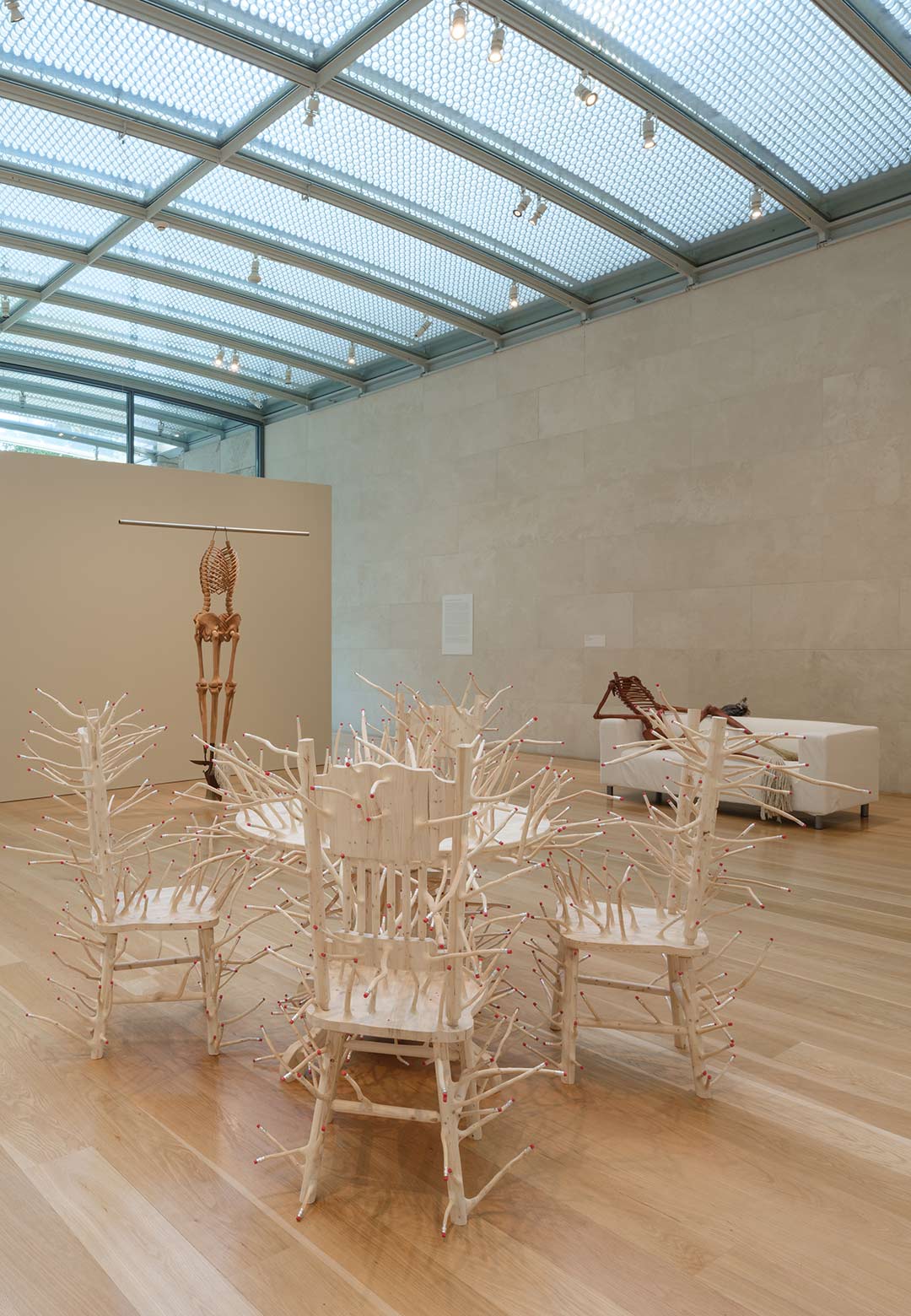With Homecoming, an exhibition of new works on display at the Nasher Sculpture Center, New York-based artist Hugh Hayden returns to the place he grew up—Dallas. The city in the Southern United States becomes a well of memories from which Hayden draws to create his sculpture designs, deconstructing the idea of the 'American Dream'. While the show's official release mentions that the works—everyday objects, wooden furniture such as the Adirondack chairs (the ubiquitous chair design associated with porches in American houses) or basketball hoops transformed into things that border on the sinister are meant to be "a metaphor for the fraught pursuit of achievement and status"—some feel like very personal reflections on the experience of growing up in orthodox settings, especially for someone from a marginalised community.
This is most evident in what is meant to be a key component for the art exhibition on view from September 14, 2024 - January 5, 2025, Brush (2024), which plays on the nostalgia permeating the rest of the showcase. A playground, sculpted entirely from unpainted wood reminiscent of children's treehouses or Medieval forts, stands in the middle of the exhibition space. The design for children, 'Kidsville' was originally envisioned by Robert Leathers, an artist and architect. It was funded and constructed by volunteer residents of the Dallas suburb of Duncanville in 1989. Through the large-scale installation, Hayden on the one hand mourns the loss of structures such as these, where local communities came together to build and then use them while celebrating the third spaces that are fast disappearing in America. Playing on that idea of disappearance, the children's playground remains ultimately inaccessible, covered with boar hair bristles. The inaccessibility makes one question further, who these spaces are inaccessible or dangerous to.
The installation is positioned between the other two sections of the gallery that reinterpret objects from domestic and public spaces. In the section that recreates the home, a kitchen table and chairs covered in pencils sit in the centre. A sofa (more specifically the loveseat from Ikea) with a wooden skeleton lying lankly on it sits in one corner, while in another, a wooden doll modelled after Pinocchio looks out from a playpen. While the thorny table design and chairs, titled Supper (2024) are meant to signify the notion of family and gathering, these themes are twisted, sinister. "For me, it's a symbol of the American family. As a round table, it's also this idea that everyone has equal access to it. But I wanted to investigate further the idea of family in America. Who is this dream open to? A heterosexual, cis-gendered nuclear family composed of a husband and wife with their children. This idea is now in flux, it's no longer assumed," Hayden explains. Apart from this, Get Together presents a set of skillets that are mounted on a wall and bear human faces. Alluding to the history of slavery, Hayden says of the sculptural art, "I think of Southern food as the only real American food. In colonial America, who was in the kitchen? Who was nourishing America? That was enslaved Africans in the kitchen, mostly with cast iron."
The skeleton towards one end of the staged domestic space, Laure—named for the 19th century art model who appears in Édouard Manet's Olympia (1863) as the maid—with feet made of mops and hands of a duster and a plunger, brings into conversation the idea of Black communities and domestic help in the American South. On the opposite end of the gallery, the doll, Pecanocchio (2024), is meant to be Hayden's stand-in. The sculpture artist, who works primarily with wood, has made many different versions of Pinocchio previously, with different woods. Here, Pecanocchio carved from pecan, even wears an outfit such as the one worn by the artist in childhood: a corduroy jumper and custom white leather shoes.
For Hayden, wood carving and carpentry become mediums through which to make viewers reexamine our perceptions of ourselves, and our otherwise familiar environments. Often, the American artist has used wood that has multi-layered meanings and histories such as discarded trunks, rare indigenous timbers, Christmas trees or souvenir African sculptures, allowing each artefact to reflect the materials' complex cultural background. Through material and symbolic juxtapositions, Hayden crafts metaphors for human existence, questioning the stasis of social dynamics.
This question of social dynamics is best explored in the section that morphs familiar objects associated with public spaces frequented by teenagers: high school, the gym and church (a phenomenon perhaps most associated with the deeply religious belt of America). Here, a cafeteria table dominates the space. Cutting Board (2024), bracketed by mirror-clad walls, is similarly covered in pencils, with their sharpened ends pointing upwards this time. The work is an allusion to "political debates around free school lunches, shifts in nutritional standards and the social anxieties of navigating a seat during lunch period," according to the wall text, with the thorny furniture design underscoring the sense of unease underlying most of the works on display.
Homecoming could also be a nostalgic reference to the traditional high school dance at the end of the year, usually centred around an athletic event. Sports are often important for the social dynamics of high schools in the country, and this is portrayed in the art installation, Blending In (2024). A row of lockers, with one open up, shows a bark-covered football uniform. Hayden has previously used the image of covering cloth with bark to signify "anxieties or pressures about how we appear to others, particularly how we disguise or camouflage ourselves to blend in or feel ‘natural’ within certain social circumstances," he states, giving relevance to the work's title.
In all of the works on display at the art gallery, Hayden takes the familiar and often nostalgic—fairytales, high school equipment, playpens and furniture—and transforms them into somewhat sinister subjects to signify themes of exclusion, discomfort and unsettling. None of what we associate with warm feelings of nostalgia is treated so in Hayden's oeuvre. Instead, the works confront the otherwise difficult and disorienting act of coming home, where everything has transformed and our memories are only that—memories. The use of unsettling elements in the uncanny sculptures where Hayden not only makes the viewer uncomfortable but brings into dialogue the strangeness in the ordinary: the experience of growing up as a Black teenager in Texas, a particularly relevant theme, especially now. While utterly specific, the sculptures presented are easily recognisable symbols of childhood for Hayden's generation, bringing up the visceral anxieties associated with growing up.
Hugh Hayden's 'Homecoming' is on view from September 14, 2024 - January 5, 2025, at the Nasher Sculpture Center, Dallas US.






 Sign in with email
Sign in with email










What do you think?